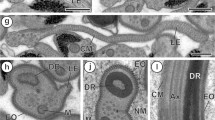Synopsis
In this investigation we have studied the influence of the protein components of different types of chromatin on the acid hydrolysis pattern of DNA. The addition of NaCl or mercaptoethanol or both to the hydrolysis bath was found to increase considerably both the depurination and the depolymerization speed. These treatments were also found to alter the form of the hydrolysis patterns obtained under standard conditions for a number of cell types. Thus salmon and bull spermatozoa, which are widely different in their BAO-hydrolysis patterns when hydrolysed in pure acid, exhibit close similarities in their pattern after the addition of NaCl and mercaptoethanol to the hydrolysis bath. The spermatozoan DNA seemed to be stabilized in a much simpler way than the somatic cells, e.g. ascites cells and avian erythrocytes, which were far more resistant to the treatments. The results point towards the existence of functional similarities in the examined types of spermatozoa.
Similar content being viewed by others
References
Alfert, M. (1959). Cytochemische untersuchungen an basischen kernproteinen während gametenbildung, befruchtung und entwicklung. In:Chemie der Genetik, pp. 72–84. Berlin: Springer.
Andersson, G. K. A. &Kjellstrand, P. T. T. (1971). Exposure and removal of stainable groups during Feulgen acid hydrolysis of fixed chromatine at different temperatures.Histochemie 27, 165–72.
Andersson, G. K. A. &Kjellstrand, P. T. T. (1972). Influence of acid concentration and temperature on fixed chromatine during Feulgen hydrolysis.Histochemie 30, 108–14.
Andersson, G. K. A. &Kjellstrand, P. T. T. (1975). A study of DNA depolymerisation during Feulgen acid hydrolysis.Histochemistry 43, 123–30.
Bedford, J. M. (1970). Sperm capacitation and fertilization in mammals.Biol. Reprod. suppl. 2:2 128–58.
Bedford, J. M. &Calvin, H. I. (1974). The occurrence and possible functional significance of-S-S-crosslinks in sperm heads, with particular reference to euterian mammals.J. exp. Zool. 188, 137–56.
Hlock, D. P. (1969). A catalog of sperm histones.Genetics suppl. 61:1, 93–111.
Elock, D. P. &Hew, H. Y. C. (1960a). Changes in nuclear histones during fertilisation, and early embryonic development in the pulmonate snail, Helix aspersa.J. biophys. biochem. Cytol. 8, 69–81.
Block, D. P. &Hew, H. Y. C. (1960b). Schedule of spermatogenesis in the pulmonate snail Helix aspersa with special reference to histone transition.J. biophys. biochem. Cytol. 7, 515–32.
Bobrow, M. (1973). Acridine orange and the investigation of chromosome banding.Cold Spring Harbour Symp. Quant. Biol. 38, 435–40.
Coelingh, J. P., Rozijn, T. H. &Monfoort, C. H. (1969). Isolation and partial characterisation of a basic protein from bovine sperm heads.Biochim. biophys. Acta 188, 353–6.
Distefano, H. S. (1948a). A cytochemical study of the Feulgen nucleal reaction.Chromosoma 3, 282–301.
Di Stefano, H. S. (1948b). A cytochemical study of the Feulgen nucleal reaction.Proc. natn. Acad. Sci. U.S.A. 34, 75–80.
Hiramato, Y. (1962). Micro-injection of live spermatozoa into sea urchin eggs.Expl. Cell Res. 27, 416–26.
Hunter, R. H. F. (1967). Polyspermic fertilisation in pigs during the luteal phase of the estrous cycle.J. exp. Zool. 165, 451–60.
Kjellstrand, P. T. T. &Andersson, G. K. A. (1975). Histochemical properties of spermatozoa and somatic cells. I. Relations between the Feulgen hydrolysis pattern and the composition of the nucleoproteins.Histochem. J. 7, 563–73.
Ofd, M. G. &Stocken, L. A. (1968). Variations in the phosphate content and thiol disulphide ratio of histones during the cell cycle. Studies with regenerating rat liver and sea urchins.Biochem. J. 107, 403–10.
Rigler, R. (1966). Microfluorometric characterization of intracellular nucleic acids and nucleoproteins by acridine orange.Acta physiol. scand. 67, suppl. 267.
Ruch, F. (1966). Determination of DNA content by microfluorometry. In:Introduction to Quantitative Cytochemistry (ed. G. Wied), pp. 281–94. New York: Academic Press.
Ruch, F. (1970). Principles and some applications of cytofluorometry. In:Introduction to Quantitative Cytochemistry—II (eds. G. L. Wied and G. F. Bahr), pp. 431–50. New York, London: Academic Press.
Vendrely, R. &Vendrely, C. (1966). Biochemistry of histones and protamines.Protoplasmatologia 5, 1–88.
Author information
Authors and Affiliations
Rights and permissions
About this article
Cite this article
Kjellstrand, P.T.T., Andersson, G.K.A. Histochemical properties of spermatozoa and somatic cells. II. Differences in the Feulgen hydrolysis pattern induced through alterations of the nucleoprotein complex. Histochem J 7, 575–583 (1975). https://doi.org/10.1007/BF01003795
Received:
Revised:
Issue Date:
DOI: https://doi.org/10.1007/BF01003795



